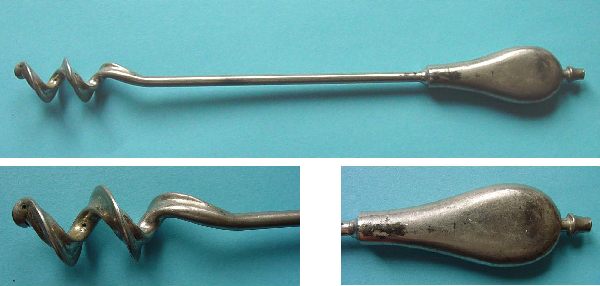|
"An early 20th century Gyn spiral uterine auger curette. This curette can be introduced through a very slightly dilated cervix, and by slight turning of the handle and using the curette motion the blade of this curette will separate completely every particle of an adhered placenta, without injuring the uterine walls. It is indispensible in miscarriages" (Sears & Roebuck surgical Instrument Catalog, 1904).
Die Spiralkürette wurde insbesondere bei puerperalen Infektionen eingesetzt, um die mit infektiösem Material gefüllte Uterushöhle zu säubern:
"Puerperal Infection: The treatment that is most successful in the various forms of puerperal infection which has saved many patients, for the writer, where others had failed and where our general form of treatment failed as well, is what will be given below. This varies according to the nature of infection, as well as severity of the case. For these reasons it should be understood whether the infection is caused by the streptococcus, staphylococcus, gonococcus, bacillus coli communis or some other putrefactive organism. The most violent form is the streptococcus infection, the form in which there is no offensive odor to the discharge; In the mixed infection of above and the staphylococcus there is only very little odor, if any; while in infection of the bacillus coli communis or other putrefactive organism the discharge has an offensive foul odor and the uterus will be found to contain a large amount of necrotic material; the discharge as a result is very foul smelling. In these cases there is a formation of gas in the uterus for reasons given. From above it can be seen that it is easy to differentiate between the different forms of infection, except where we have a mixed infection of streptococcus or staphylococcus or both, with the bacillus coli communis or other putrefactive organism or more of these. However, in such cases we find that after curetting the temperature will remain high, or, if it goes down, only remains low for a very short while, only to rise again rapidly. That curetting is indicated in infection of bacillus coli communis or other putrefactive organism is an established fact, for the reason that the infection is more confined to the endometrium. Again, in purely streptococcus or staphylococcus infection, but especially the former, the change in the endometrium is very little, it being found on examination to be very smooth. In these cases the germ spreads rapidly along the lymphatics, or veins or both, from the uterus and general systemic infection is the result, which is often associated or followed by various complications, such as purulent pleurisy, pneumonia, peritonitis or phlegmasia alba dolens. In some cases all these complications are present. Now before going into the systemic treatment of puerperal infections a few words on the local and antiseptic treatment are to be considered carefully. The utmost care should be exercised in this direction even to the minutest details. It is a well known fact that sudden collapse has resulted from carbolic acid uterine douches. It is also a well known fact that bichloride douches are dangerous. Many women die from absorption, cases being on record where one uterine douche of 1:4000 has resulted in death from mercurial poisoning. Are these not reasons enough to condemn the use of bichloride douches? In infection of putrefactive organism, where the uterine discharge is foul smelling and curetting is indicated, the spiral curette is the quickest, safest and most convenient" (Fred J. Petersen, M.D., Materia Medica and Clinical Therapeutics, 1905).
"Auger-Curette" d.h. Spiralkürette - Import aus Bradenton/Florida. In den USA sieht man diese Kürette immer wieder in geburtshilflichen Bestecken aus der Zeit um 1900. Länge 30 cm.
Bei uns ist dieser Typ von Kürette mit seiner an die Saugkürette von AUVARD (1855-1941) (siehe Kapitel Gynäkologie, Saugkürette) erinnernden Absaugvorrichtung völlig unbekannt!
|




